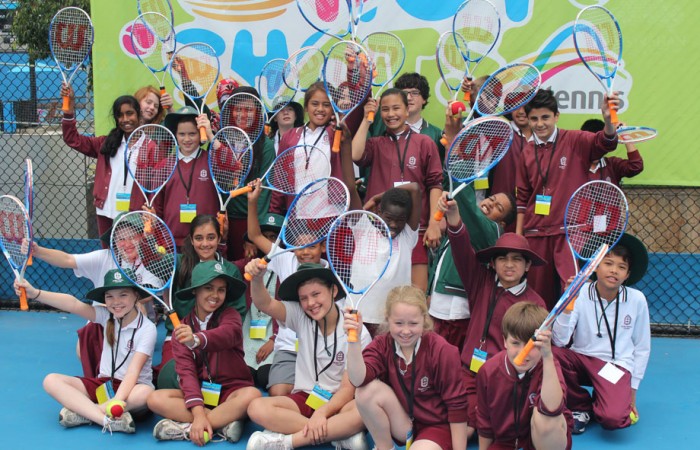Tennis day trip
Sat in a semi-circle, their hands raised reaching high, pulling their bodies up with excitement, a collective “Me, me, me, me!” rings out until the teacher relents picking one fifth grader.
Melbourne Park, 16 December 2012 | James Crabtree

Sat in a semi-circle, their hands raised reaching high, pulling their bodies up with excitement, a collective “Me, me, me, me!” rings out until the teacher relents picking one fifth grader.
“Yes Rebecca, what’s your question?”
“How did you get so good at tennis?” asks the girl beneath a giant brimmed hat that not only shades her from the sun but also obscures her face.
Luke Saville smiles from the inadvertent compliment then replies with distinct courteousness, “Good question,” before throwing a signed ball over to the girl. “Well, my whole family plays tennis and my dad’s an engineer so he built a court and wall at home, so I guess that helped. Other than that I just love the game and would play all the time.”
The group of 60 or so 11-year-olds, from Chatham Primary School in Surrey Hills, briefly digest the answer before their hands once again reach up to the sky.
“What was it like to win junior Wimbledon and do you get nervous before a match?” another boy asks excitedly.
“Very nervous,” Luke replies quickly, to a group he could have been sitting with only seven years prior, “And, yes, winning junior Wimbledon was pretty special. I was the No.16 seed so I really wasn’t expected to win.”
The children continue to barrage the two time junior Grand Slam champion with questions that vary in range from “What food do you eat?” to “Who is your favourite player?” in the hope of learning more and winning a signed ball.
After the question and answer session the children are split into three groups, the first of which is taken on a tour of Rod Laver Arena. Here the schoolchildren are given an inside glimpse into the world of the professional player, gaining access to areas usually under guard. Quickly they retrieve their cameras and snap with paparazzi like vigour within the walls of one of the four holy lands of tennis.
Along the way they are informed of facts about the arena itself, history of the tournament and details of past players. An unassuming door leads to the players’ locker room, which one boy adds with a giggle, “I thought it would be smelly, but it wasn’t.”
In hushed tones details of the past winners odd and obscure superstitions are leaked prompting one girl to remark to her friend that “some players are crazy.” Another door leads to the Walk of Champions where the children yell out the names of the images that line the walls – Djokovic, Federer and Nadal! All while flooding their memory cards with photos of their respective heroes.
After a quick drink break and plastering of sunscreen, the MLC Tennis Hot Shots program leads the children onto the court to play, running through fun drills that start with movement then progressing subliminally to hand-eye and racquet-ball coordination then rallying.
“It’s a great way to introduce kids to tennis and get them hitting straight away. It allows them to play quickly and easily with modified racquets and balls,” states Hot Shots Tournament Coordinator Jarrod Kennedy.
“What’s amazing for the schools is this opportunity is provided for free here at Melbourne Park which is a special experience for all the kids who journey in from near, far and wide.”
Kennedy elaborates that the MLC Hot Shots initiative has more than 25,000 registered participants and boasts over 105,000 participants from schools alone.
“It gets them active at a young age and they even leave with a show bag.” He talks of the ever popular bag that includes a magazine, pencil case, sticker, poster, wrist band, and iPhone app that he himself also has on his phone. Ultimately he concludes with a gleam in his eyes, “What we want is the next champion and Hot Shots is a really great start.”
“The kids really do love it,” adds Cathie Bradford, a teacher of over 20 years and someone who has been coming to the Australian Open herself since the mid-1970s. “It is such a perfect way to expose the kids to healthy living and tennis. Something we all need.”
After 30 minutes on the court the group marches on for their final instalment. Here they witness Priscilla Hon register a three-set upset victory over her more experienced opponent Sally Peers. Courtside the children’s eyes dart back and forth following the hard struck ball from player to player, fixated with admiration on a skill they may one day master; a sport they may one day love.